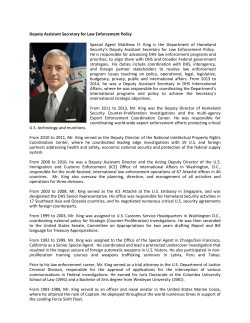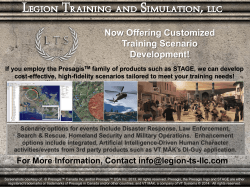
âResilient Infrastructureâ
320 West 31st Street New York, NY 10001 212-594-4000 www.tcicollege.edu TCI College - April 2015 Joining the National Conversation on Homeland Security Technology Tom Capone New York Distance Learning Association (NYDLA), Executive Director tom@nydla.org Tom is the Executive Director of the NYDLA (www.nydla.org) and also has over 30 years of experience in the Telecom and Technology industries. The NYDLA services 46% of the trillion-dollar education market for technology based learning systems (TBLS). As the Director of Sales and Marketing for the USDLA (www.usdla.org), Tom advocates the mission is to serve the distance learning community by providing advocacy, information, networking and opportunity. The US Distance Learning Association helps its members stay connected and ahead of trends in learning — distance learning , e-learning, mobile learning, computer-based training (CBT), web-based training (WBT), instructor-led training (ILT), online training, online learning, blended learning, classroom training, webinars and more. Mitchell D. Erickson, Ph.D. NYDLA, Chairman of the Advisory Board mitch@nydla.org Mitch is a chemist with specific expertise in environmental science. He is a strong advocate of distance learning for academic, occupational, avocational, and recreational learners. Mitch has held multiple volunteering positions for his alma mater, Grinnell College, and received their Alumni Award in 2007. He has held numerous volunteer positions for the Boy Scouts of America. He is a passionate proponent of STEM, notably for BSA. Dr. Erickson is a Science Advisor (Senior Executive) for DHS Science and Technology. He establishes trusted partnerships with other agencies so that we can leverage each other’s resources and investments. Partnership is his currency; cost-savings is the result. Dr. Erickson has had various technical and management positions. Notably, he was the Director of DHS’ National Urban Security Technology Laboratory in New York City for over a decade. Dr. Erickson’s research career was in environmental science and analytical chemistry. He earned his PhD in Analytical Chemistry from the University of Iowa. Dr. Erickson holds one patent and is the author of over 150 technical publications, including two books – Analytical Chemistry of PCBs and Remediation of PCB Spills. DEPARTMENT OF HOMELAND SECURITY Science & Technology (S&T) S&T has launched the National Conversation on Homeland Security Technology, a series of online and in-person discussions that has people talking about how to innovate solutions for the Nation’s homeland security challenges. Our mission is to foster exchange between operational users and innovators to generate sustainable solutions that will help keep our communities and those who protect them safe and resilient. The National Conversation will revolve around the following five primary topic-based dialogues, which have been previously communicated as our Visionary goals (http://www.dhs.gov/science-and-technology/visionary-goals). S&T’s Visionary Goals Screening at Speed: Security that Matches the Pace of Life Noninvasive screening at speed will provide for comprehensive threat protection while adapting security to the pace of life rather than life to security. Unobtrusive screening of people, baggage, or cargo will enable the seamless detection of threats while respecting privacy, with minimal impact to the pace of travel and speed of commerce. Trusted Cyber Future: Protecting Privacy, Commerce, and Community In a future of increasing cyber connections, underlying digital infrastructure will be self-detecting, selfprotecting, and self-healing. Users will trust that information is protected, illegal use is deterred, and privacy is not compromised. Security will operate seamlessly in the background. Enable the Decision Maker: Actionable Information at the Speed of Thought Predictive analytics, risk analysis, and modeling and simulation systems will enable critical and proactive decisions to be made based on the most relevant information, transforming data into actionable information. Even in the face of uncertain environments involving chemical, biological, radiological, or nuclear incidents, accurate, credible, and context-based information will empower the aware decision maker to take instant actions to improve critical outcomes. Responder of the Future: Protected, Connected, and Fully Aware The responder of the future is threat-adaptive and cross-functional. Armed with comprehensive physical protection, interoperable tools, and networked threat detection and mitigation capabilities, responders of the future will be better able to serve their communities. Resilient Communities: Disaster-Proofing Society Critical infrastructure of the future will be designed, built, and maintained to withstand naturally occurring and man-made disasters. Decision makers will know when a disaster is coming, anticipate the effects, and use already-in-place or rapidly deployed countermeasures to shield communities from negative consequences. Resilient communities struck by disasters will not only bounce back, but bounce forward. ABOUT DHS S&T: S&T’s mission is to deliver effective and innovative insight, methods and solutions for the critical needs of the Homeland Security Enterprise. You can learn more about us by exploring our website at http://www.dhs.gov/science-and-technology
© Copyright 2025











